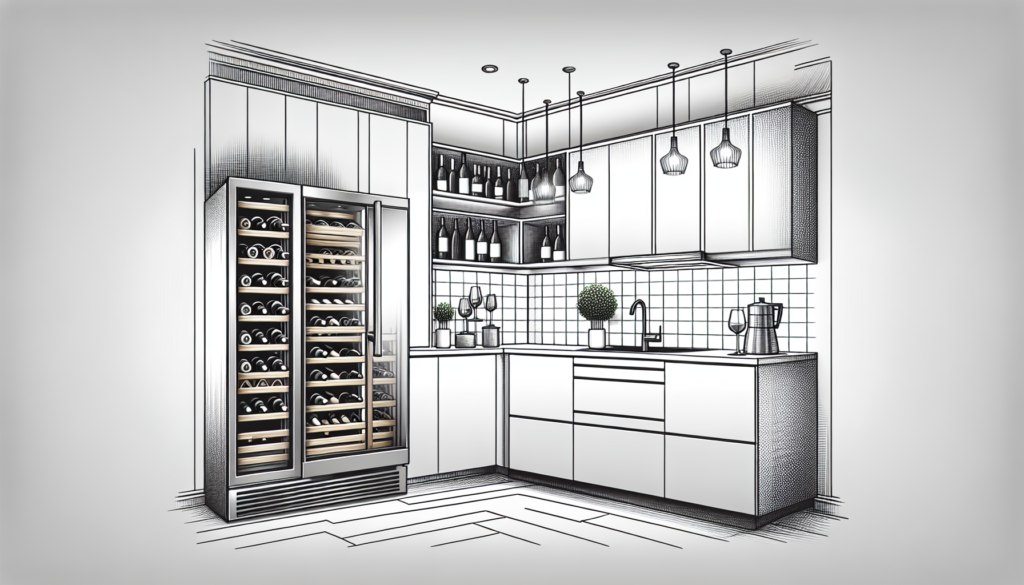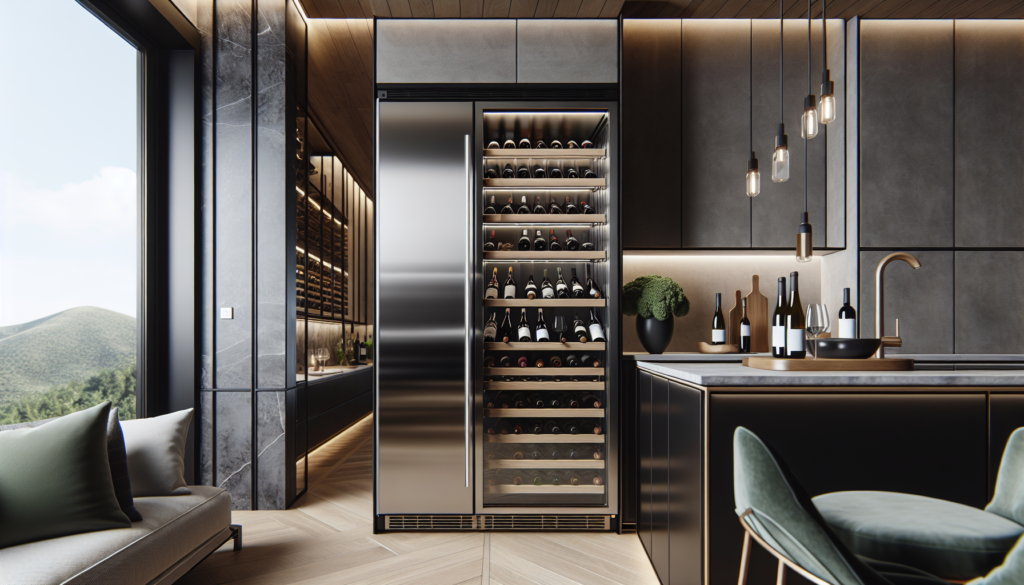Imagine having the perfect place to store and chill your favorite wines, right in the comfort of your own home. With a wine fridge built in, you can easily achieve this dream. Say goodbye to the hassle of searching through cluttered cupboards or digging through the pantry to find that perfect bottle for a special occasion. A wine fridge built in provides a stylish and convenient solution for wine enthusiasts looking to preserve and showcase their collection. Whether you’re a casual wine drinker or a connoisseur, this article will explore the benefits and features of a wine fridge built in, making it a must-have addition for any home.
What is a Wine Fridge Built In?
Definition
A wine fridge built-in, also known as a wine cooler or wine refrigerator, is a specialized appliance designed specifically for storing and preserving wine. Unlike regular refrigerators, which are set at lower temperatures, a wine fridge built-in is designed to maintain the optimal temperature and humidity levels required for storing wine.
Purpose
The main purpose of a wine fridge built-in is to provide the perfect storage conditions for wine. Wine is a delicate beverage that requires specific environmental conditions in order to preserve its flavor, aroma, and overall quality. A wine fridge built-in ensures that these conditions are met consistently, allowing wine enthusiasts to store their collection properly and enjoy it at its best.
Features of a Wine Fridge Built In
Temperature Control
One of the key features of a wine fridge built-in is its temperature control capability. Wine is best stored at a consistent temperature of around 55 degrees Fahrenheit (13 degrees Celsius). A wine fridge built-in allows you to set and maintain this ideal temperature, ensuring that your wine ages gracefully and retains its flavors.
Humidity Control
Humidity is another important factor in wine storage. Too much humidity can lead to mold growth on the corks, while too little can cause the corks to dry out and allow air to enter the bottles, resulting in oxidation. A wine fridge built-in typically comes with humidity control features to maintain the appropriate levels, usually between 50-70%, to keep the corks moist and prevent any damage to the wine.
LED Lighting
LED lighting is a common feature in wine fridges built-in as it provides a soft, even glow that highlights your wine collection without emitting excessive heat. LED lights also have a longer lifespan and are more energy-efficient compared to traditional incandescent bulbs, making them an ideal choice for illuminating your wines.
Dual Zone Cooling
Some wine fridges built-in come with dual zone cooling, which allows you to store different types of wine at their ideal temperatures within the same unit. With dual zone cooling, you can dedicate separate sections of the fridge to red wines and white wines, ensuring that each type is stored at its recommended temperature for optimal taste.
Vibration Control
Vibration can negatively impact the quality of wine over time. It can disturb the sediments, affect the aging process, and alter the taste. Many wine fridges built-in are designed with vibration control mechanisms to minimize or eliminate vibrations, such as special shock-absorbing systems or compressor placement, ensuring that your wines are undisturbed and age properly.
Locking Mechanism
To provide an extra layer of security, some wine fridges built-in come equipped with locking mechanisms. This can be particularly useful if you have valuable or rare wines in your collection that you want to protect from unauthorized access. The locking mechanism adds peace of mind and ensures that your wines are safe and secure.

Benefits of a Wine Fridge Built In
Preservation
The most significant benefit of a wine fridge built-in is its ability to preserve the quality of your wines over time. By providing optimal temperature and humidity levels, as well as protection from light and vibration, a wine fridge built-in ensures that your wines age gracefully, maintaining their flavors, aromas, and characteristics for a longer period.
Easy Access
Having a wine fridge built-in provides convenient access to your collection. You can easily organize and display your wines, making it effortless to find the bottle you want without rummaging through the shelves of a regular refrigerator or cellar. With a wine fridge built-in, your wine collection is readily accessible, allowing you to enjoy a glass whenever you desire.
Convenience
A wine fridge built-in offers convenience by eliminating the need for external storage solutions and providing a dedicated space for your wine collection. It saves you from the hassle of finding suitable storage areas or renting off-site wine storage facilities. With a wine fridge built-in, you can store your wines at home, ensuring they are always readily available for special occasions or impromptu gatherings.
Stylish Design
Wine fridges built-in are designed to be aesthetically pleasing and blend seamlessly with your kitchen or bar area. They come in various sizes, finishes, and styles to suit different interior design preferences. Whether you prefer a sleek stainless steel finish or a more classic wood trim, a wine fridge built-in adds a touch of elegance and sophistication to your space.
Added Property Value
Installing a wine fridge built-in can enhance the value of your property. It is considered a desirable feature by wine enthusiasts and can attract potential buyers who appreciate a well-maintained and curated wine collection. If you ever decide to sell your home, having a wine fridge built-in can make it stand out and potentially increase its market appeal.
Factors to Consider Before Buying a Wine Fridge Built In
Size and Capacity
Before purchasing a wine fridge built-in, it is essential to consider the size and capacity that will meet your needs. Assess the number of bottles you currently have or plan to acquire in the future and choose a wine fridge built-in that can accommodate your collection. Remember to leave some extra space for airflow and future expansion.
Type of Cooling
Different wine fridges built-in use various cooling technologies, including compressor-based cooling, thermoelectric cooling, or a combination of both. Compressor-based cooling systems are more powerful and suitable for larger collections, while thermoelectric cooling systems are quieter and more energy-efficient. Consider your cooling requirements and choose a system that aligns with them.
Installation Requirements
Installing a wine fridge built-in requires some preparation and consideration. Think about the location where you want to place it and ensure that it meets the necessary ventilation and electrical requirements. Measure the available space accurately and consider any built-in cabinetry or countertops that may be affected. Additionally, consult a professional if needed to ensure proper installation.
Budget
Establishing a budget is crucial before purchasing a wine fridge built-in. Determine how much you are willing to invest in a quality appliance that will meet your requirements. Keep in mind that while higher-end models may come with more features and advanced technology, they can also be more expensive. Consider the long-term benefits and choose a wine fridge built-in that fits within your budget.
Brand and Quality
When selecting a wine fridge built-in, it is important to consider the brand and quality of the appliance. Look for reputable brands that have a track record of producing reliable and durable products. Read reviews, seek recommendations, and research the warranties and customer support provided by different brands to ensure you are investing in a high-quality wine fridge built-in.

How to Choose the Right Wine Fridge Built In
Determine Your Needs
Start by assessing your specific needs and requirements. Consider the size of your wine collection, the types of wines you have, and any future additions you plan on making. Determine if you need dual-zone cooling, locking mechanisms, or any other specific features based on your needs and preferences.
Assess Available Space
Measure the area where you plan to install the wine fridge built-in. Consider the height, width, and depth restrictions, as well as any surrounding cabinetry or countertops. This will help you determine the size and capacity of the wine fridge built-in that will fit perfectly in your space.
Consider Cooling Requirements
Think about the cooling requirements for your wine collection. If you predominantly store red or white wines, a single-zone cooling system may be sufficient. However, if you have a diverse collection with different storage temperature requirements, opt for a wine fridge built-in with dual-zone cooling capabilities.
Research Different Brands
Take the time to research and compare different brands of wine fridges built-in. Look for reputable brands, read customer reviews, and assess the features and quality of each option. Pay attention to warranty information, customer support, and any additional services offered by the brands.
Read Customer Reviews
Customer reviews can provide valuable insights into the performance, reliability, and overall satisfaction with a particular wine fridge built-in. Take the time to read reviews from other wine enthusiasts who have purchased and used the models you are considering. This will give you a better understanding of the pros and cons of each option and help you make an informed decision.
Installation Process for a Wine Fridge Built In
Preparation
Before starting the installation process, gather all the necessary tools and equipment. Read the manufacturer’s installation instructions thoroughly to ensure you understand the process and any specific requirements. Prepare the installation area by clearing the space and ensuring proper ventilation.
Finding the Perfect Spot
Choose a suitable location for your wine fridge built-in. Ideally, it should be placed away from direct sunlight, heat sources, or areas with excessive moisture. Ensure that there is enough clearance around the unit for proper airflow and ventilation. Consider any built-in cabinetry or countertops that may need to be adjusted to accommodate the wine fridge built-in.
Professional Installation
While some individuals may opt for a DIY installation, it is highly recommended to seek professional installation for a wine fridge built-in. Professional installers have the necessary expertise and tools to ensure a proper installation, including electrical connections, ventilation requirements, and leveling the unit.
Proper Ventilation
Proper ventilation is crucial for the efficient operation of a wine fridge built-in. Follow the manufacturer’s instructions for ventilation requirements and ensure that there is adequate space around the unit for proper airflow. Improper ventilation can lead to overheating, reduced cooling efficiency, and potential damage to the appliance.
Testing and Maintenance
After installation, test the wine fridge built-in to ensure it is functioning correctly. Check the temperature and humidity levels to ensure they are within the desired range. Familiarize yourself with the maintenance requirements, such as regular cleaning, filter replacement, and any other necessary maintenance tasks outlined in the manufacturer’s instructions.
Tips for Maintaining a Wine Fridge Built In
Regular Cleaning
Regular cleaning is essential to maintain the cleanliness and hygiene of your wine fridge built-in. Clean the interior surfaces, shelves, and racks using mild detergent and a soft cloth. Avoid using abrasive cleaners or harsh chemicals that may damage the interior or leave behind unwanted odors.
Temperature and Humidity Monitoring
Keep a close eye on the temperature and humidity levels inside the wine fridge built-in. Use a digital thermometer and hygrometer to monitor these levels regularly. Make any necessary adjustments to ensure the optimal conditions for your wines.
Proper Shelving
Organize your wines on the shelves of the wine fridge built-in based on their type, vintage, or any other categorization that works for you. Ensure that the bottles are stored horizontally to keep the corks moist and prevent them from drying out. Avoid overcrowding the shelves, as this may impede proper airflow and cooling.
Avoiding Vibration and Sunlight
Minimize vibrations and exposure to sunlight as much as possible. Vibration can disturb the sediments in the wine, while sunlight can lead to premature aging and spoilage. Choose a stable location for your wine fridge built-in and avoid placing it near appliances or areas with excessive vibrations. If the wine fridge built-in doesn’t have UV-protected glass, consider covering it or placing it away from direct sunlight.
Replacing Seals and Gaskets
Check the seals and gaskets of the wine fridge built-in regularly to ensure they are intact and free from any damage or wear. Damaged seals and gaskets can affect the cooling efficiency and lead to temperature fluctuations. If necessary, replace the seals and gaskets to maintain the optimal conditions inside the appliance.
Common Problems and Troubleshooting for a Wine Fridge Built In
Incorrect Temperature
If the temperature inside the wine fridge built-in is not at the desired level, check the thermostat settings and ensure they are correctly adjusted. If the problem persists, consult the manufacturer’s troubleshooting guide or contact customer support for further assistance.
Excessive Noise or Vibration
Excessive noise or vibration can indicate a problem with the wine fridge built-in. Ensure that the unit is level and stable on the floor. Check for any loose components or objects that may be causing the noise or vibration. If the issue persists, contact a qualified technician to diagnose and resolve the problem.
Leaks or Condensation
If you notice any leaks or excessive condensation inside the wine fridge built-in, inspect the door seals and gaskets for any damage or misalignment. Clean the seals and gaskets to remove any debris or residue that may be affecting their performance. If the issue continues, consult the manufacturer or seek professional assistance.
Faulty Lighting
If the LED lighting in the wine fridge built-in is not functioning correctly, check the power connection and ensure that it is securely plugged in. If the lights still do not work, there may be a problem with the lighting system, and it is advisable to contact a professional for repair or replacement.
Door Issues
If you encounter any difficulties with the wine fridge built-in door, such as improper sealing or difficulty opening and closing, check for any obstructions or objects that may be blocking the door’s path. Clean the door seals and gaskets to ensure a proper seal. If the problem persists, consult the manufacturer or seek professional help.
Malfunctioning Controls
If the controls on the wine fridge built-in are not responding or functioning as intended, check the power supply and ensure it is properly connected. If the controls continue to malfunction, consult the manufacturer’s troubleshooting guide or contact customer support for further assistance.
Wine Fridge Built In vs. Freestanding Wine Fridge
Design and Aesthetics
A wine fridge built-in is designed to seamlessly integrate with your kitchen or bar area, blending in with your existing cabinetry and appliances. It offers a more streamlined and integrated look, enhancing the overall aesthetics of your space. In contrast, a freestanding wine fridge tends to have a standalone appearance and may not integrate as seamlessly with your existing décor.
Installation Flexibility
A wine fridge built-in requires careful planning and installation due to its integration with the surrounding cabinetry and countertops. It is typically fixed in a specified space and may be more challenging to relocate or reposition. On the other hand, a freestanding wine fridge offers more flexibility and can be placed anywhere with adequate ventilation.
Cooling Technology
Both wine fridges built-in and freestanding wine fridges offer similar cooling technologies, such as compressor-based or thermoelectric cooling systems. The choice between the two depends more on personal preference and the specific requirements of your wine collection rather than the type of wine fridge.
Cost
In general, wine fridges built-in tend to be more expensive compared to freestanding wine fridges. The integration, customization, and installation factors contribute to the higher cost. If budget is a significant consideration, a freestanding wine fridge may be a more cost-effective option while still providing adequate storage and cooling capabilities.
Popular Brands for Wine Fridge Built In
Sub-Zero
Sub-Zero is a well-known brand in the appliance industry and offers a range of high-quality wine fridges built-in. Their wine coolers are known for their excellent temperature control, quality construction, and stylish design. Sub-Zero wine fridges built-in are often praised for their reliability and long lifespan.
Liebherr
Liebherr is another reputable brand that produces high-quality wine fridges built-in. Their wine coolers feature advanced cooling technology, precise temperature control, and excellent energy efficiency. Liebherr wine fridges built-in are favored for their sleek design, quiet operation, and the variety of sizes and configurations available.
Vinotemp
Vinotemp is a brand that specializes in wine storage solutions, including wine fridges built-in. Their wine coolers are known for their innovative features, customizable options, and reliable performance. Vinotemp offers a wide range of sizes and capacities to accommodate various wine collections and personal preferences.
Whirlpool
Whirlpool is a trusted brand in the appliance industry, and their wine fridges built-in offer reliable performance and quality construction. Whirlpool wine coolers are often praised for their affordable price points, efficient cooling capabilities, and ease of use. They provide a good balance between quality and affordability.
Edgestar
Edgestar is a brand that focuses on compact and space-saving wine fridges built-in. Their units are ideal for smaller kitchens or those with limited space, offering efficient cooling and stylish designs. Edgestar wine fridges built-in are recognized for their affordability, versatility, and ease of installation.
In conclusion, a wine fridge built-in is a valuable addition for any wine enthusiast. It provides the ideal storage conditions to preserve the quality and flavors of your wines over time. With features such as temperature and humidity control, dual-zone cooling, and stylish design, a wine fridge built-in offers convenience, easy access, and added property value. Before purchasing, consider factors like size, cooling technology, installation, budget, and brand reputation. Follow the installation process carefully and maintain the appliance through regular cleaning and monitoring. If issues arise, troubleshoot or seek professional assistance. Lastly, compare the benefits and differences between wine fridges built-in and freestanding options to choose the right one for your needs. Popular brands like Sub-Zero, Liebherr, Vinotemp, Whirlpool, and Edgestar offer reliable and quality options to consider. Enjoy the convenience and preservation that a wine fridge built-in brings to your wine collection.
